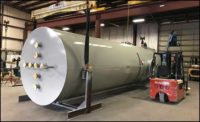
A heating system evened out the temperature and improved working conditions at this Alaska Air Force hangar.
Extreme sub-arctic temperatures at Eielson Air Force Base near Fairbanks, AK, where winter temperatures often plunge far below zero, make working conditions especially challenging for the Alaska Air National Guard based there.
Extreme cold, sometimes 50° below or even colder, means maintaining heating systems is essential to mission readiness.
QUICK RESULTS
To steady interior temperatures, reduce energy bills, and improve worker comfort in large hangars where doors are opened and closed regularly for aircraft maintenance, the Alaska Air Guard 168th Refueling Wing chose the Air Pear Thermal Equalizer system, manufactured by Airius LLC in Longmont, CO. After just one night with the Air Pear system installed and running throughout one hangar’s ceiling, engineers were surprised at how quickly the temperature evened out throughout the facility.A second hangar will be fitted with the Air Pear system this spring. “We have a maintenance catwalk way up high to take care of some equipment,” said Scott Lammers, who oversees facilities management engineering for the State of Alaska and Air Guard.
“The next morning I noticed when I got up on the catwalk how much cooler that area was. It was like the whole chamber was one temperature. The hangars are used primarily to work on Air Force KC-35R Stratotanker, a refueling aircraft. Hangar doors were opened to bring in large lifts to install the Air Pear system. Then a plane was brought in, with the hangar closed for the night as the Air Pear fans operated for the first time.
“When we walked in that hangar the first thing the next morning, we noticed how much hotter the hangar floor slab was,” said Lammers, who says he may be able to lower the digitally controlled floor temperature, saving on heating costs. The Air Pear destratification system utilizes a multiple-unit approach to balance temperatures from floor to ceiling, resulting in no more than a 0° to 3° differential and reducing the run time of heating or cooling systems. Airius customers using the Air Pear system, ranging from military installations to big - box groceries to school and government facilities, report savings of up to 30% in annual energy costs.
EXCEEDING EXPECTATIONS
Air Guard officials installed a system of two Model 45s, six Model 60s, and four Model 100s (the largest of six different available Air Pear models) in the first hangar. Each Air Pear is designed to service 400 to 2,500 sq ft and will work in any building with ceilings from 8 to 100 ft high. The Air Force, the largest energy user in the Department of Defense, is beginning several initiatives to reduce the demand on foreign oil.Typically, the Eielson base hangar maintains a temperature of about 65° at floor level to work on aircraft. The floor is warmed by a slab heat exchanger using the base’s centralized steam power plant. After the Air Pear system was installed by Inlet Electrical Contractors and ran at 100% for the first night, the temperature on the hangar floor rose to about 80° the next morning, said Curtis Cherrier, president of Inlet Electrical. Some of the Air Pear units then were readjusted to run at only 75%.
The State of Alaska and Air Guard officials, Cherrier said, “were really pleased with it. I think it exceeded their expectations.” The units working together had a “significant” effect, with the larger Model 100s installed at about 68 feet and the Model 60s and 45s installed lower at about 40 ft. ES

